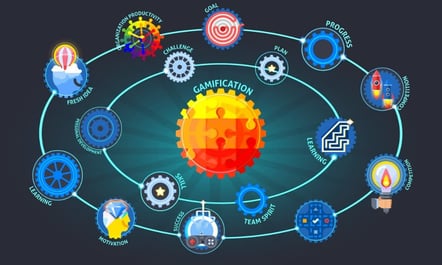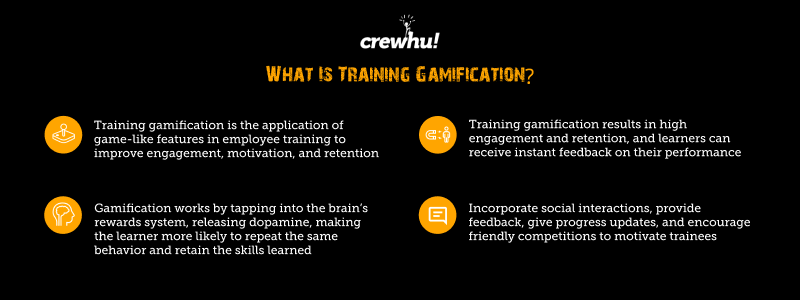What Is Training Gamification?

If Gamifying your training draws in disengaged employees and delivers the training in a fun way that makes employees more likely to remember and utilize the skills they learn.
 According to Training magazine, organizations spend about 16% of their annual budget on employee training. But even with such a considerable investment, companies don’t measure the effectiveness of the training, and employees lose about 90% of the new skills they learn within a year.
According to Training magazine, organizations spend about 16% of their annual budget on employee training. But even with such a considerable investment, companies don’t measure the effectiveness of the training, and employees lose about 90% of the new skills they learn within a year.
Why doesn’t this training “stick”? Likely because employees aren’t engaging with the training content and activities. Training gamification is the addition of game-like elements to employee learning programs to improve engagement, so you can achieve your training goals and build an effective workforce.
Here’s how training gamification works, its benefits, and tips for developing a successful strategy.
How gamification works in training
Gamification in training works by stimulating the brain’s pleasure centers. When users earn rewards, such as badges, levels, and points, their brains release dopamine, “the feel-good hormone.” This makes the experience pleasurable, which helps employees retain what they learn.
Gamification also triggers the release of serotonin, “the happy hormone,” and other pleasure hormones known as endorphins. Triggering all these hormones will keep your employees “hooked” on the training.
Another way gamification works is by drawing from the learners’ intrinsic and extrinsic motivations. When they climb up the leaderboard and earn badges, it taps into their deeper desire for achievement and keeps them engaged.
Humans are naturally inclined to repeat behaviors they find satisfying. As such, earning points and badges and climbing up the leaderboard can result in a deeper level of gratification. Your employees will be more likely to repeat behaviors that result in satisfaction, which reinforces the lessons and helps them retain what they have learned in the long run.
Benefits of training gamification
In addition to just being fun, training gamification offers numerous benefits to your organization. These include:
1. High engagement and productivity
One of the significant advantages is the ability to engage employees better than through traditional training. By creating fun challenges, tracking users’ progress, and rewarding them when they reach a goal, the training will keep them motivated enough to continue.
Because they’re fully engaged in the training, employees can easily apply what they have learned to their work, resulting in high productivity. Motivated employees also experience less burnout.
2. Improved retention
Gamified training helps workers retain more of what they learned. When achievements are rewarded, learners are more likely to repeat the behavior that led to the reward, thus improving retention rates.
In fact, research shows that gamification increases retention by 40%. So if you’re looking for an effective training strategy that helps your employees retain what they learn and utilize it in their work, gamification is the way to go.
3. Real-time enforcement and feedback
In gamified training, learners receive feedback instantly. They can quickly correct wrong answers while receiving rewards for the right ones, positively reinforcing the learning process.
Because learners don’t have to wait to find out where they went wrong, they can easily retain the right information and get a motivational boost from correcting mistakes. Positive reinforcement helps increase employee confidence in their abilities, improves morale, and breeds engagement.
As you can see, training gamification offers numerous benefits for business success. But just how do you go about implementing it?
Tips for training gamification
If you’re interested in adopting gamification techniques to your employee training programs, here are a few simple tips to help you get started. Remember, the more fun you can make it, the better.
1. Include challenges and rewards
An effective gamification strategy includes challenging trainees to complete strategic objectives and rewarding them when they achieve the goal. Include challenges such as closing the highest number of customer support tickets.
Reward learners when they achieve a goal. Rewards can include badges, points, leaderboard positions, and levels. Goal-oriented challenges test knowledge while rewarding achievements, which keeps employees motivated and engaged.
2. Provide feedback
Constructive comments and critiques will let your trainees know how they’re performing and help them address problem areas. While it can be as easy as giving a thumbs up or down, more extensive feedback will not only improve your employees’ performance, it can help you get to know them better as you appreciate their strengths and help them address their weaknesses.
3. Incorporate social interactions
Studies show that social interactions help learners reflect on what they’ve learned, organize their thoughts, and improve long-term retention rates. Including interactions through social media is the easiest way for learners to connect. They can connect with other learners, ask questions, and discuss their training. You can incorporate social media interactions in your training gamification in several ways, such as:
- Posting trivia questions
- Twitter polls
- Recognizing learners who view, like, or comment on learning content
Consider using progress bars to let trainees know how they’re doing. This helps them measure how well they’re performing and where they need to improve.
Progress updates also tap into human nature to avoid loss, such as loss of time, points, and achievements. Any potential setback can motivate trainees to engage with the course and try to move forward.
5. Motivate trainees through friendly competitions
Humans are naturally competitive, and you can take advantage of that in your gamification strategy by encouraging friendly competition through features such as leaderboards. Employees complete their learning activities, pass quizzes and assessments to earn points, and climb up the leaderboard. Friendly competition also taps into extrinsic motivation, boosting engagement with the learning activities.
Introducing a few gamification ideas into your training can increase engagement and retention. But if you don’t have the time – or want to create a more comprehensive program – consult with the experts.
Gamify your training with CrewHu
Employee training is crucial to improving their skills and productivity in the workplace. When your workers know what they should do and how to do it, they’ll excel at their jobs.
The problem is that traditional training lacks effective measures to keep trainees engaged and help them retain the skills they learned. Training gamification helps overcome these challenges by tapping into the brain’s reward system.
If you’re looking for a way to deliver effective training and keep your employees engaged, consider engaging a gamification partner who’ll help you implement gamified training. CrewHu is a reliable partner that will foster a culture of collaboration and recognition to incentivize your team.
Book a CrewHu demo, and let us help you implement an effective training strategy.






